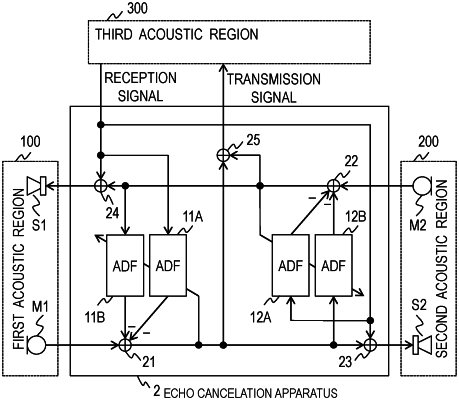| CPC H04R 3/02 (2013.01) [H04R 1/02 (2013.01)] | 3 Claims |

|
1. An echo cancelation apparatus for use in a vehicle comprising:
a first loudspeaker disposed in a first acoustic region in the vehicle;
a first microphone disposed in the first acoustic region in the vehicle;
a second loudspeaker disposed in a second acoustic region in the vehicle;
a second microphone disposed in the second acoustic region in the vehicle;
a first hands-free talking adaptive filter configured to generate a call signal component of a hands-free talking among acoustic echoes picked by the first microphone, by estimating a path from the first speaker to the first microphone and a path from the second speaker to the first microphone, using a call signal of the hands-free talking as a reference signal, the call signal of the hands-free talking being a reception signal from a third acoustic region set outside the vehicle;
a first in-car communication adaptive filter configured to generate a reproduction signal component of an in-car communication among the acoustic echoes picked by the first microphone, by estimating the path from the first speaker to the first microphone, using a reproduction signal of the in-car communication as a reference signal, the reproduction signal of the in-car communication being output from the first speaker and being a communication between the first acoustic region and the second acoustic region;
a second hands-free talking adaptive filter configured to generate a call signal component of the hands-free talking among acoustic echoes picked by the second microphone, by estimating a path from the second speaker to the second microphone and a path from the first speaker to the second microphone, using a call signal of the hands-free talking as a reference signal;
a second in-car communication adaptive filter configured to generate a reproduction signal component of the in-car communication among the acoustic echoes picked by the second microphone, by estimating the path from the second speaker to the second microphone, using a reproduction signal of the in-car communication as a reference signal, the reproduction signal of the in-car communication being output from the second speaker; and
a processing circuitry configured to:
execute the first loudspeaker to emit an acoustic signal picked up by the second microphone;
execute the second loudspeaker to emit an acoustic signal picked up by the first microphone;
cancel, from the acoustic signal picked by the first microphone, the call signal component generated by the first hands-free talking adaptive filter and the reproduction signal component generated by the first in-car communication adaptive filter, and transmit the canceled acoustic signal picked by the first microphone to the third acoustic region; and
cancel, from the acoustic signal picked by the second microphone, the call signal component generated by the second hands-free talking adaptive filter and the reproduction signal component generated by the second in-car communication adaptive filter, and transmit the canceled acoustic signal picked by the second microphone to the third acoustic region.
|